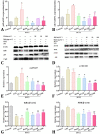An ethyl acetate fraction of flavonoids from Polygonum hydropiper L. exhibits an anti-inflammatory activity in PCV2-infected porcine alveolar macrophages via PI3K/Akt and NF-κB pathways
- PMID: 36320309
- PMCID: PMC9548224
- DOI: 10.30466/vrf.2021.137675.3070
An ethyl acetate fraction of flavonoids from Polygonum hydropiper L. exhibits an anti-inflammatory activity in PCV2-infected porcine alveolar macrophages via PI3K/Akt and NF-κB pathways
Abstract
Porcine circovirus type 2 (PCV2) widely exists in swine production systems causing porcine circovirus diseases (PCVD) which is associated with significant economic losses. Polygonum hydropiper L. was used as a traditional Chinese medicine to treat a variety of diseases. This study was carried out to investigate anti-inflammatory activity of the ethyl acetate fraction of flavonoids from Polygonum hydropiper L. (FEA) in PCV2-induced porcine alveolar macrophages (3D4/2 cell line). The production of oxygen species (ROS) and the levels of tumor necrosis factor-α (TNF-α), interleukin-1β (IL-1β) and interleukin-8 (IL-8) were detected to evaluate the anti-inflammatory activities of FEA. The translocation of nuclear factor-kappa B (NF-κB) and the phosphatidylinositol 3 kinase/protein kinase B (PI3K/Akt) signaling pathways were investigated to document the potential anti-inflammatory mechanisms. In PCV2 induced 3D4/2 cells, FEA treatment significantly reduced the production of ROS, and sharply down-regulated the levels of TNF-α, IL-1β and IL-8 in both secretion and mRNA expression level. The FEA also decreased the mRNA expression of Akt and NF-κB p65, reduced the transfer of p65 to nuclear, and inhibited the activation of PI3K/Akt signaling pathway. The findings suggest that FEA exhibited an anti-inflammatory activity in vitro and could be used as a candidate in treatment of inflammation induced by PCV2 infection.
Keywords: 3D4/2 cell; Anti-inflammatory activity; Polygonum hydropiper L.; Porcine circovirus type 2.
© 2022 Urmia University.
Conflict of interest statement
There was no conflict of interest on any front.
Figures




Similar articles
-
Normal butanol fraction of Polygonum hydropiper L. flavonoids reduces inflammation caused by PCV2 infections in cell and mouse models.Front Vet Sci. 2025 Feb 4;12:1539448. doi: 10.3389/fvets.2025.1539448. eCollection 2025. Front Vet Sci. 2025. PMID: 39968105 Free PMC article.
-
Ethyl acetate fraction of flavonoids from Polygonum hydropiper L. modulates pseudorabies virus-induced inflammation in RAW264.7 cells via the nuclear factor-kappa B and mitogen-activated protein kinase pathways.J Vet Med Sci. 2020 Dec 26;82(12):1781-1792. doi: 10.1292/jvms.20-0263. Epub 2020 Oct 1. J Vet Med Sci. 2020. PMID: 32999131 Free PMC article.
-
Porcine circovirus type 2 activates PI3K/Akt and p38 MAPK pathways to promote interleukin-10 production in macrophages via Cap interaction of gC1qR.Oncotarget. 2016 Apr 5;7(14):17492-507. doi: 10.18632/oncotarget.7362. Oncotarget. 2016. PMID: 26883107 Free PMC article.
-
Porcine circovirus type 2 increases interleukin-1beta and interleukin-10 production via the MyD88-NF-kappa B signaling pathway in porcine alveolar macrophages in vitro.J Vet Sci. 2017 Jun 30;18(2):183-191. doi: 10.4142/jvs.2017.18.2.183. J Vet Sci. 2017. PMID: 27456771 Free PMC article.
-
Porcine Circovirus Type 2 Induces Single Immunoglobulin Interleukin-1 Related Receptor (SIGIRR) Downregulation to Promote Interleukin-1β Upregulation in Porcine Alveolar Macrophage.Viruses. 2019 Nov 3;11(11):1021. doi: 10.3390/v11111021. Viruses. 2019. PMID: 31684202 Free PMC article.
Cited by
-
The genus Polygonum: An updated comprehensive review of its ethnomedicinal, phytochemical, pharmacological activities, toxicology, and phytopharmaceutical formulation.Heliyon. 2024 Apr 6;10(8):e28947. doi: 10.1016/j.heliyon.2024.e28947. eCollection 2024 Apr 30. Heliyon. 2024. PMID: 38638945 Free PMC article. Review.
-
Normal butanol fraction of Polygonum hydropiper L. flavonoids reduces inflammation caused by PCV2 infections in cell and mouse models.Front Vet Sci. 2025 Feb 4;12:1539448. doi: 10.3389/fvets.2025.1539448. eCollection 2025. Front Vet Sci. 2025. PMID: 39968105 Free PMC article.
References
-
- Meehan BM, McNeilly F, McNair I, et al. Isolation and characterization of porcine circovirus 2 from cases of sow abortion and porcine dermatitis and nephropathy syndrome. Arch Virol. 2001;146:835–842. - PubMed
-
- Martinon F, Mayor A, Tschopp J. The inflammasomes: guardians of the body. Annu Rev Immunol. 2009;27:229–265. - PubMed
-
- Basset C, Holton J, O'Mahony R, et al. Innate immunity and pathogen-host interaction. Vaccine. 2003;21 Suppl 2:S12–S23. - PubMed
LinkOut - more resources
Full Text Sources
